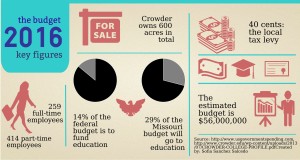I can’t be the only one who’s noticed that my instructors don’t use as much paper as the last few semesters. There is a “green” reason for this, but not the one you think of.
What is going on?
Not to freak you out, but community colleges around the State are in a state. With the instability that Crowder has had in the past few years, like the big expansions in little time, precarious funds from the State and Federal governments, and the rotation in the Administration; it is no surprise that Crowder is in the middle of a battle with the budget.
100 politicians just avoided another government shutdown, but narrowly. Sure, Crowder is not doing well financially because their budget got smaller; however, a smaller budget is a good thing for everyone.
Why is this happening?
In 2009, when the last recession was at its scariest, high school students who wanted to attend a University right away had to reconsider their plans. Crowder, like many other community colleges, saw its enrollment numbers go way up, according to the College Data posted on MyCrowder.edu.
In the Fall 2007 and 2008 there were 490 and 464 first-time, full-time, degree seeking students (FTFTDS), respectively. By Fall 2009, enrollment jumped to 694; Fall 2010 saw 856 FTFTDS; and fall 2011 had 814 such students. This means that when the rate of unemployment jumped from 5.8 in 2008 to 9.3 in 2009, according to the Bureau of Labor Statistics.
I know, numbers suck, so let me break it down for you. There is an inverse relation between the rate of students who enroll and graduate compared to the rate of unemployment. The Community College Review posted some possibilities of why this might be, but it boils down to: when people are laid off and can’t find a job, some return to college to get a degree for a better job.
The demographics make a difference
Again, MyCrowder shows the college has a third of its student population made up from students 25 years and older. So, in general, now that the economy is in the upswing, the employment rate is also better, and students aren’t forced by their finances to go to community college instead of 4-year colleges. Some people who might have been students also may decide not to go to college at all. While that sucks for our enrollment numbers, that means that only interested students attend Crowder, which may help our graduation rates.
Do less students necessarily mean less quality? Crowder is a comparatively small school, both in size of campus and in terms of enrollment. Unless the administration chooses to make all of its instructors adjunct, which is a terrible idea by the way; the rate of faculty-to-student is relatively small. This means that instructors are more likely to know your name and face than in schools that have auditoriums for classrooms. Smaller classes still might mean a higher-rate of quality education for its student body.
How it is beneficial
Missouri Governor Jay Nixon has a plan in place that would grant 6% more in funds for community colleges; this means that the school could get $300,000 or more. As the saying goes, there is no such thing as a free lunch, however: $50,000 need to be allocated on science, technology, engineering, and math (STEM) majors. Still, that is still a win-win: Missouri gets more STEM graduates, Crowder gets to keep the lights on, and students don’t see their tuition increase terribly.
Crowder has eight physical campuses: Cassville, Carthage, McDonald County, Monett, Mt. Vernon, Neosho, Nevada, and Webb City, and students can also take online classes. This expansion that Crowder did could ultimately be that which contributes to the lower enrollment. If full-time employees don’t have to travel that far to be enrolled in community college classes, they might just take a few classes and not necessarily get an Associate’s degree.
Lastly, another benefit is better parking! If we have less students on-campus in Neosho, I may be able to park somewhere reasonably in front of the Farber building.






Leave a Reply